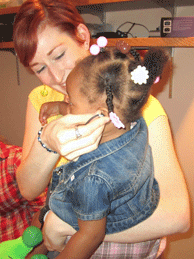In taking American Sign Language to fulfill her foreign language requirement, Rachel Romeo, C'11, often interacted with the Philadelphia Deaf community. She came across several people who said they'd suffered ear infections or diseases like meningitis in early childhood, and as a result, had developed hearing impairments that had gone undetected. These stories raised a red flag in the psychology and linguistics double major.
"If hearing impairments go undiagnosed and unaddressed for too long," Romeo explains, "a child can miss out on crucial linguistic information. The longer this goes on, the less ability he or she will have to learn language, whether it is sign language, spoken language, reading or writing."
Romeo had already been studying language acquisition in children at Penn's Infant Language Center. So she approached her advisor and center director, Associate Professor of Psychology Daniel Swingley, with the idea of expanding the research to an atypical population of children with hearing deviations.
One of the techniques Swingley's lab uses to understand language development is "language-guided looking," which analyzes eye movements to determine how children are interpreting language. Children are shown sets of pictures of different objects—for example a dog and a car—and one is named in a sentence (e.g. "Where's the dog?"). If they know the word, they have an automatic tendency to look at the object named. As children get older and become more sophisticated language users, they respond more quickly and accurately in their looking.
"If hearing impairments go undiagnosed and unaddressed for too long, a child can miss out on crucial linguistic information. The longer this goes on, the less ability he or she will have to learn language, whether it is sign language, spoken language, reading or writing." – Rachel Romeo
Some of the lab's studies use language-guided looking to ascertain children's language processing and speech discrimination abilities by examining their response to mispronunciations—testing, for example, how a child will respond to the abovementioned pictures when presented with the word "tog" or "dawk." Children as young as 14 months look at the named picture more accurately when the word is pronounced correctly—signifying that they must know how the word is supposed to sound.
"Language-guided looking shows us that even before children can say anything, they know a lot more about language than they can tell you," Romeo explains.
Working with Swingley and Children's Hospital of Philadelphia audiologist Dr. Eileen Rall, Romeo began a study this spring that is examining whether looking patterns in response to mispronunciation are different in children with and without a history of chronic ear infections. Romeo starts testing her subjects whey they are 14 months old, and then at three-and-a-half month intervals until they are 28 months old. This way, she can also study how any differences in looking patterns change over time.
One goal of Romeo's research is to assess whether chronic ear infections can disrupt language learning during the critical first months of life and if those disruptions have prolonged effects. Eventually, she hopes this study will help evaluate language-guided looking as a clinical diagnostic tool for detecting audiological impairments in very young children.
"Currently, the effects of hearing problems on language learning are not reliably detected before age three," Romeo says, "and by that time a lot of damage to language development is permanent. We know that the earlier interventions happen, the more they are successful. Diagnostic models using language-guided looking could be the key to early detection—even in infants as young as six month of age."
Funded by a grant from the Center for Undergraduate Research and Fellowships, Romeo will continue this study through her senior year—and she loves every minute in the lab. "Despite the challenges of working with 14-month-olds—a little earwax can throw a whole test off—it's really rewarding to work with children and see them grow," she says. "It's amazing at such a young age how much they learn in such a short period of time."
She credits her liberal arts experience for giving her the freedom to discover a subject about which she is so passionate. "I started out thinking I'd be a math major, and I had never even heard of linguistics," she says. "I now want to pursue an academic research career devoted to helping eliminate childhood language disorders."



